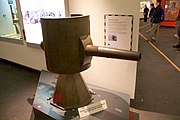5.7 cm Maxim-Nordenfelt
| 5.7 cm Maxim-Nordenfelt | ||
|---|---|---|
Breech Vertical sliding-block | | |
| Carriage | Box trail | |
| Elevation | -10° to +15°[1] | |
| Rate of fire | 36 rpm | |
| Muzzle velocity | 401 m/s (1,320 ft/s) | |
| Effective firing range | 2.7 km (1.7 mi) | |
| Maximum firing range | 6.4 km (4 mi)[1] | |
The 5.7 cm Maxim-Nordenfelt "Canon de caponnière" was a fortress gun and
Design
Fortress gun
In 1887 the Belgian War Ministry ordered 185 5.7 cm fortress guns to arm their fortresses including Namur and Liege. The 5.7 cm Maxim-Nordenfelt was a short 26 caliber gun and not the longer 42-50 caliber QF 6-pounder Nordenfelt naval gun. It was a typical built-up gun of the period made of steel with a vertical sliding-block breech and it fired fixed QF ammunition of a number of different styles. The guns were mounted in Grusonwerke gun turrets or in armored casemates on central pivot mounts and used in an anti-personnel role.[1]
Infantry gun
In addition to its fortress gun role, it was deployed in an infantry gun role. The guns were mounted on light two-wheeled box trail carriages without a recoil mechanism and protected by a three-sided gun shield. During 1914 the Germans captured large numbers of these guns and used them in the infantry gun role mainly to engage enemy machine gun nests in support of infantry assaults. In 1916 the Germans had 450 of these infantry guns in service.[1]
Tank gun and anti-tank gun
In addition to the infantry gun role, the Germans used a number of guns to arm their A7V tanks and the guns were mounted in an armored casemate at the front of the vehicle with limited traverse. The Germans also mounted a number guns on central-pivot mounts on flatbed truck chassis to act as mobile anti-tank guns.[1]
Belgian Forts
- Fort d'Andoy
- Fort de Barchon
- Fort de Boncelles
- Fort de Chaudfontaine
- Fort de Cognelée
- Fort de Dave
- Fort d'Embourg
- Fort d'Emines
- Fort d'Évegnée
- Fort de Flémalle
- Fort de Fléron
- Fort de Hollogne
- Fort de Lantin
- Fort de Liers
- Fort de Loncin
- Fort de Maizeret
- Fort de Malonne
- Fort de Marchovelette
- Fort de Pontisse
- Fort de Saint-Héribert
- Fort de Suarlée
- Fortified position of Liège
- Fortified position of Namur
Photo Gallery
-
A captured German 5.7 cm Maxim-Nordenfelt gun with destroyed shield. Meaulte-Albert Road after the Battle of the Somme.
-
Captured guns in a depot.
-
A Belgian casemate gun recaptured by American troops.
-
A7V tank gun at the Imperial War Museum North, Manchester, England
References
- ^ )
- ^ "48-57 MM CALIBRE CARTRIDGES". www.quarryhs.co.uk. Archived from the original on 2021-03-01. Retrieved 2018-09-23.




